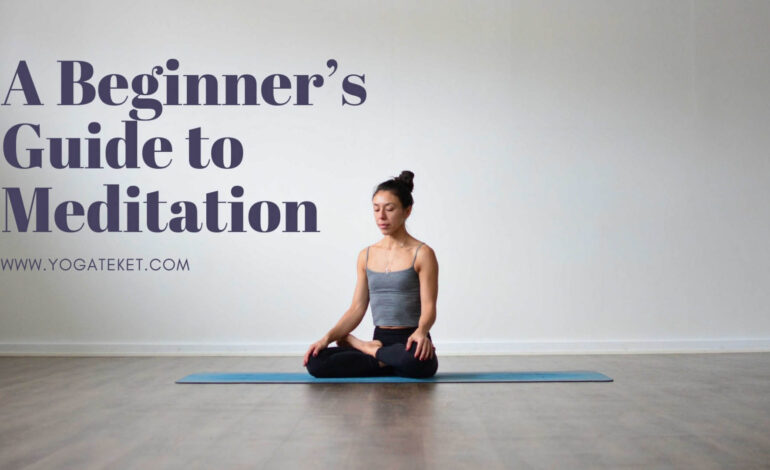Yoga & Meditation for Beginners

“`html
A Beginner’s Journey into Yoga and Meditation
Welcome! If you’re feeling overwhelmed by the daily grind, seeking a path towards greater well-being, or simply curious about what all the buzz is about, you’ve landed in the right place. This guide will serve as your comprehensive introduction to both yoga and meditation – two powerful practices often intertwined, offering incredible benefits for mind, body, and spirit. We’ll break down the basics, dispel common misconceptions, and provide practical steps to get you started on your own journey.
Understanding Yoga: More Than Just Stretching
When most people hear “yoga,” they picture someone contorted into an impossible pose. While flexibility is certainly *a* benefit of yoga, it’s only a small piece of the puzzle. Yoga is actually a centuries-old practice originating in India, encompassing physical postures (asanas), breathing techniques (pranayama), and ethical principles (yamas & niyamas). It’s a holistic system designed to unite the mind, body, and spirit.
Different Styles of Yoga: There’s no one “yoga” – various styles exist, each with its own emphasis. Here are some popular beginner-friendly options:
- Hatha Yoga: Often considered a foundational style, Hatha focuses on holding poses for longer durations and emphasizes breath awareness. It’s generally slower paced and a great starting point for beginners.
- Restorative Yoga: This gentle practice involves supported poses held for extended periods (often with blankets or bolsters), promoting deep relaxation and stress reduction. Perfect if you’re feeling depleted.
- Yin Yoga: Similar to restorative, Yin yoga focuses on targeting the deeper connective tissues through passive poses. It encourages stillness and introspection.
- Vinyasa Flow Yoga: A more dynamic style linking breath with movement in a flowing sequence of postures. It builds strength and endurance but might be best approached after some experience with Hatha.
The Eight Limbs of Yoga: Patanjali’s Yoga Sutras outline the eight limbs, a roadmap for spiritual growth:
- Yamas (Ethical Restraints): Principles like non-violence, truthfulness, and non-stealing.
- Niyamas (Observances): Practices such as cleanliness, contentment, and self-discipline.
- Asana (Physical Postures): The postures we typically associate with yoga.
- Pranayama (Breath Control): Techniques to regulate breath for various benefits.
- Pratyahara (Withdrawal of the Senses): Turning inward and detaching from external distractions.
- Dharana (Concentration): Focusing the mind on a single point.
- Dhyana (Meditation): A state of sustained concentration, leading to deeper awareness.
- Samadhi (Union): A state of blissful union with the divine or ultimate reality – the goal of yoga practice.
Getting Started with Yoga: Practical Tips
Finding a Class or Instructor: Look for beginner-friendly classes at local studios, community centers, or online platforms. Research instructors to ensure they align with your goals and experience level.

Home Practice: Numerous online resources offer yoga sequences suitable for beginners. Start with short sessions (15-20 minutes) and gradually increase the duration as you build strength and flexibility.
Essential Equipment: You don’t need much! A yoga mat is a good investment, but you can start on a carpeted floor. Comfortable clothing that allows for movement is key.
Listen to Your Body: Yoga isn’t about pushing yourself beyond your limits. Pay attention to any pain or discomfort and modify poses as needed. Respect your body’s limitations – it’s not a competition!
Delving into Meditation: Calming the Mind
Meditation, at its core, is simply training the mind to focus. It’s about cultivating awareness of the present moment without judgment. While often perceived as difficult or esoteric, meditation can be surprisingly accessible with a little practice.
Types of Meditation:
- Mindfulness Meditation: The most common type for beginners. You focus on your breath, bodily sensations, sounds, or thoughts without getting carried away by them. When your mind wanders (and it *will* wander!), gently guide it back to your chosen anchor.
- Guided Meditation: Listening to a recorded meditation where a facilitator guides you through visualizations and affirmations. Excellent for beginners as it provides structure.
- Loving-Kindness Meditation (Metta): Cultivating feelings of compassion and kindness towards yourself and others.
- Transcendental Meditation (TM): Uses mantras or sound vibrations to quiet the mind – typically requires instruction from a certified teacher.
Tips for Successful Meditation
Find a Quiet Space: Minimize distractions by choosing a peaceful environment where you won’t be interrupted.
Start Small: Begin with just 5-10 minutes of daily meditation and gradually increase the duration as you become more comfortable. Consistency is key!
Posture Matters: Sit comfortably, whether on a cushion, chair, or floor, maintaining an upright but relaxed posture.
Don’t Fight Your Thoughts: It’s natural for your mind to wander. Don’t get frustrated; simply acknowledge the thought and gently redirect your attention back to your breath or chosen focus.
Be Patient: Meditation is a practice, not a performance. It takes time and dedication to cultivate mental stillness.
The Synergy of Yoga & Meditation
Yoga and meditation are incredibly complementary practices. Yoga prepares the body for meditation by releasing tension and increasing awareness. The breathwork (pranayama) practiced in yoga directly supports meditative states, calming the nervous system and enhancing focus.
Many people find that incorporating both practices into their daily routine leads to a profound sense of well-being – reduced stress, increased clarity, improved emotional regulation, and a deeper connection to themselves.
Conclusion: Your Journey Begins Now!
Embarking on the path of yoga and meditation is an investment in your overall health and happiness. Don’t be intimidated by the perceived complexity; start small, be patient with yourself, and enjoy the process. The benefits—both physical and mental—are well worth the effort.
Remember, there’s no right or wrong way to practice – find what resonates with you and make it a sustainable part of your life.
Resources for Further Exploration
- Yoga Journal: https://www.yogajournal.com/
- Insight Timer (Meditation App): https://insighttimer.com/
- Headspace (Meditation App): https://www.headspace.com/
“`



